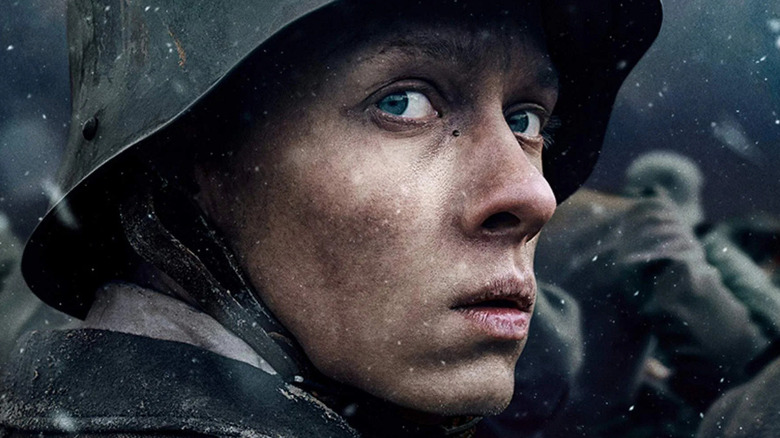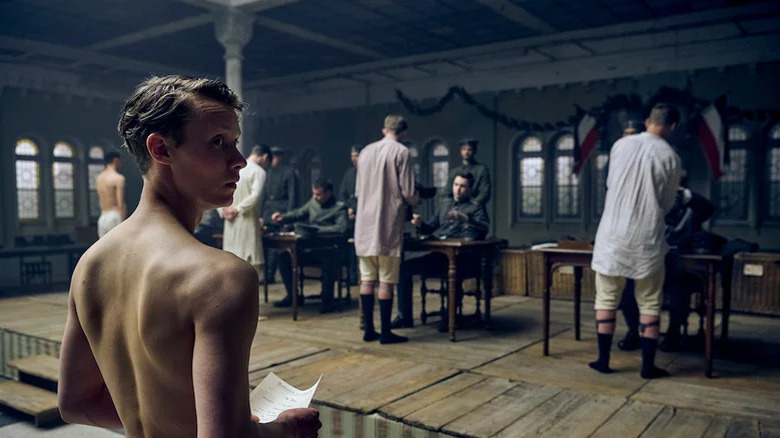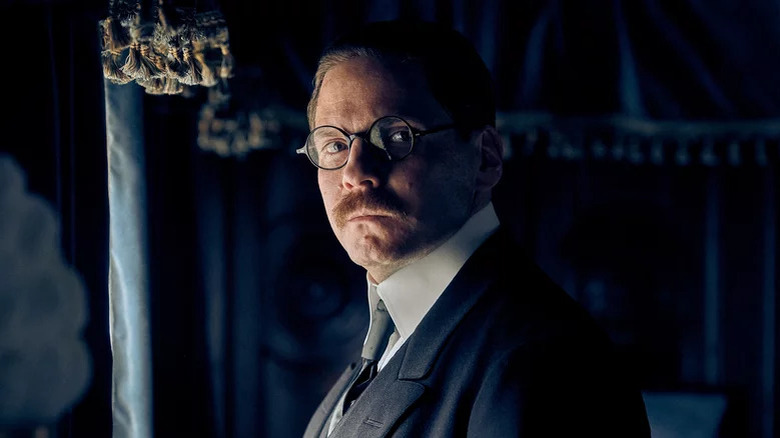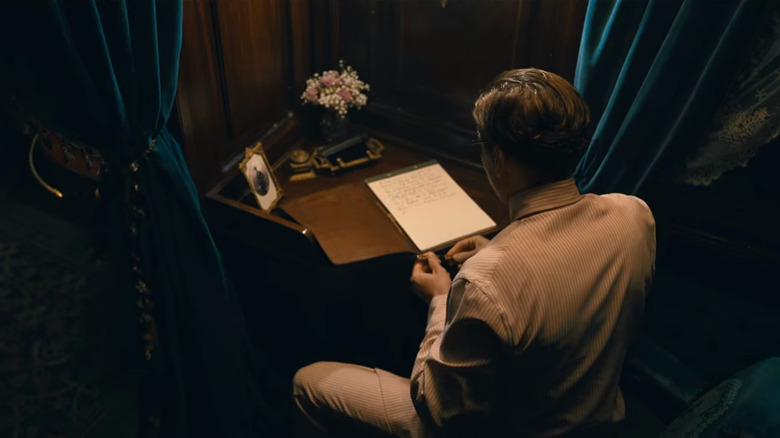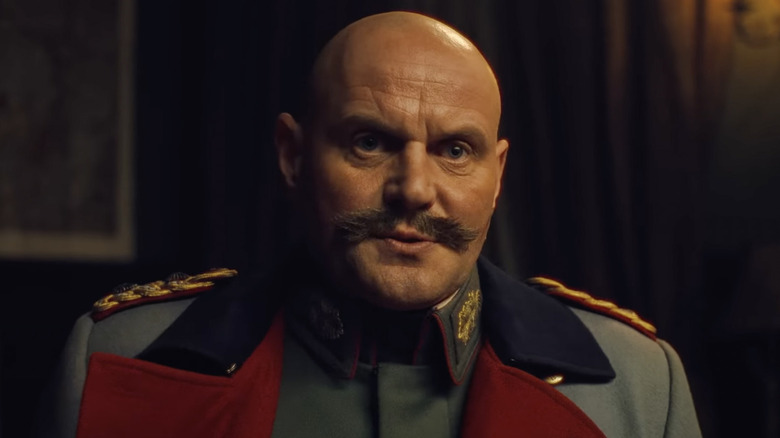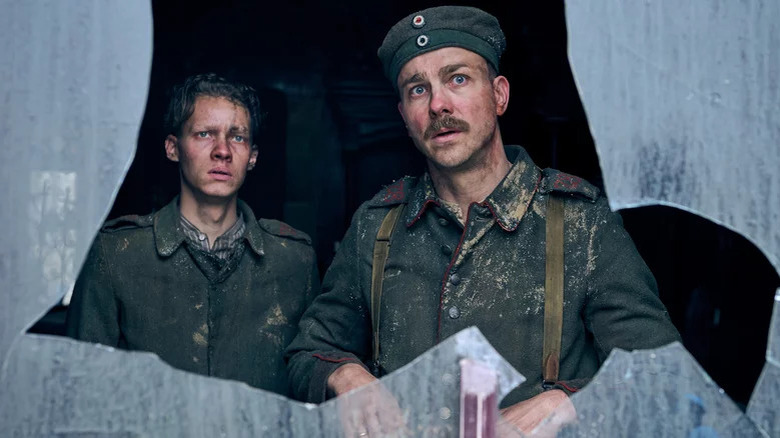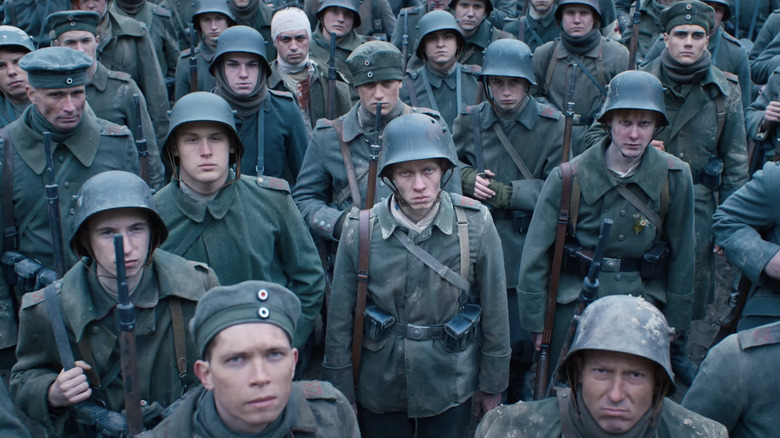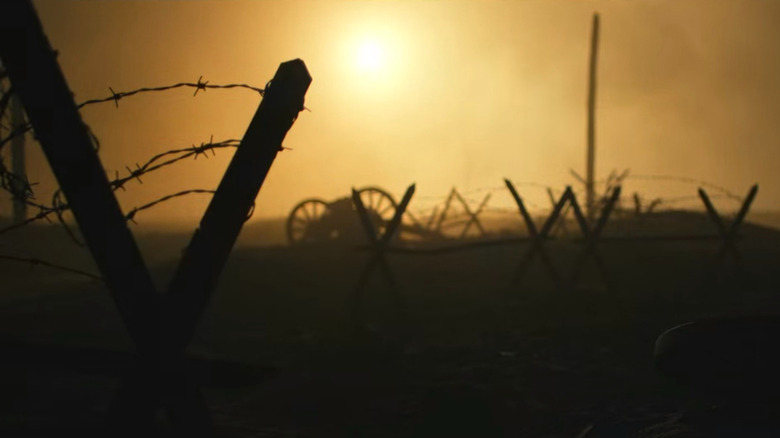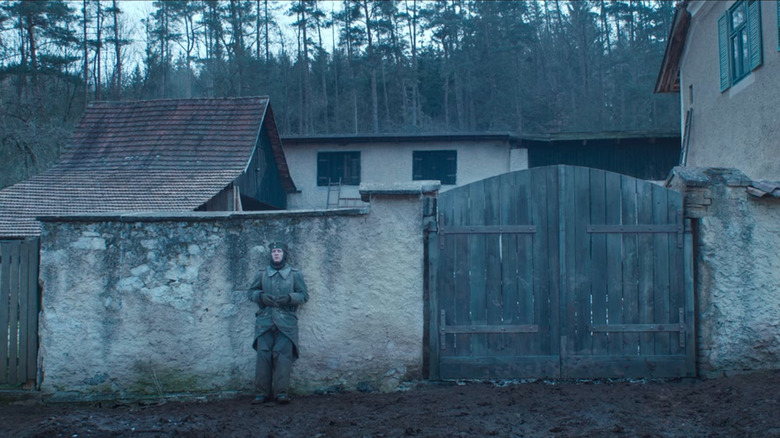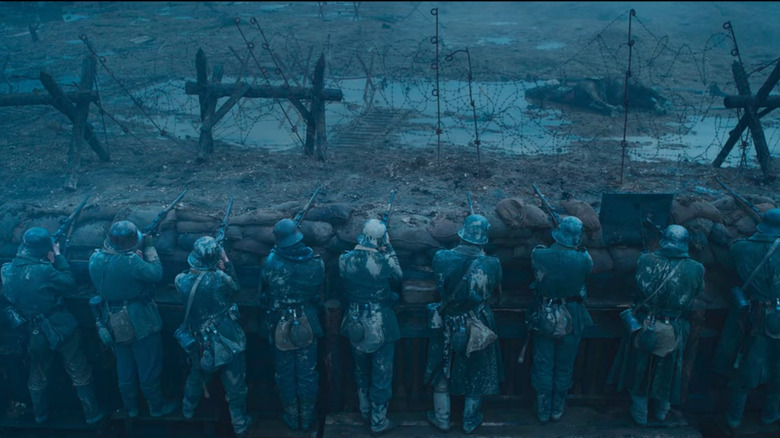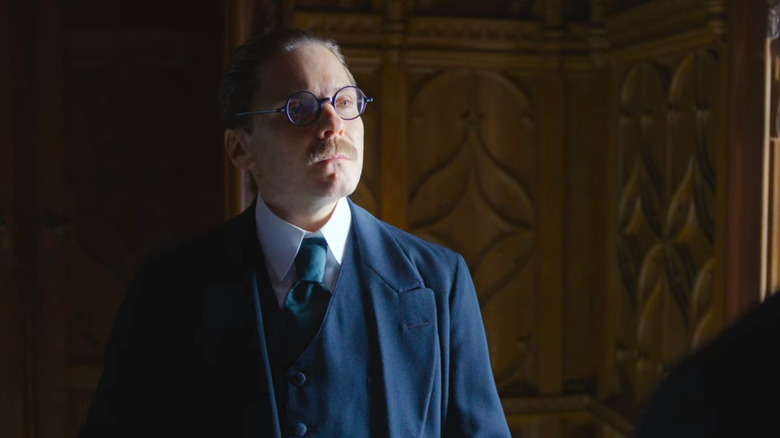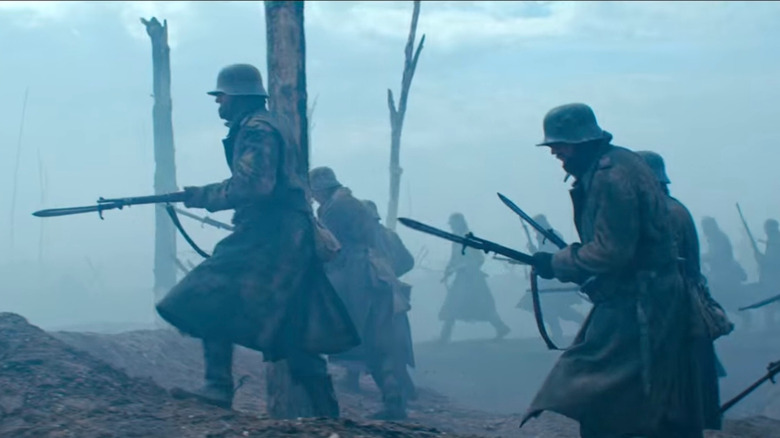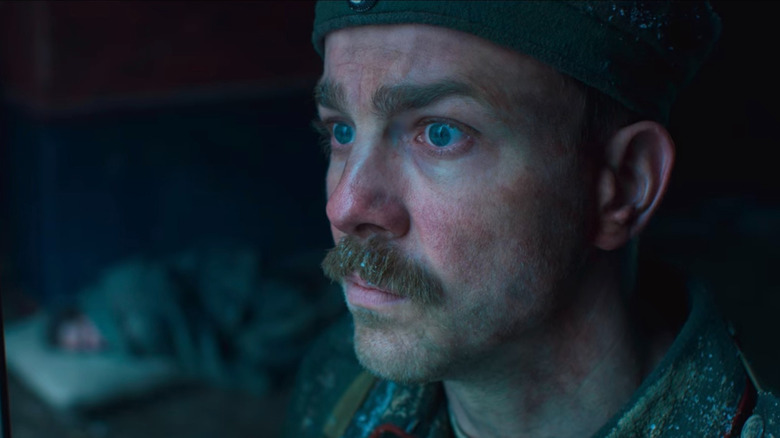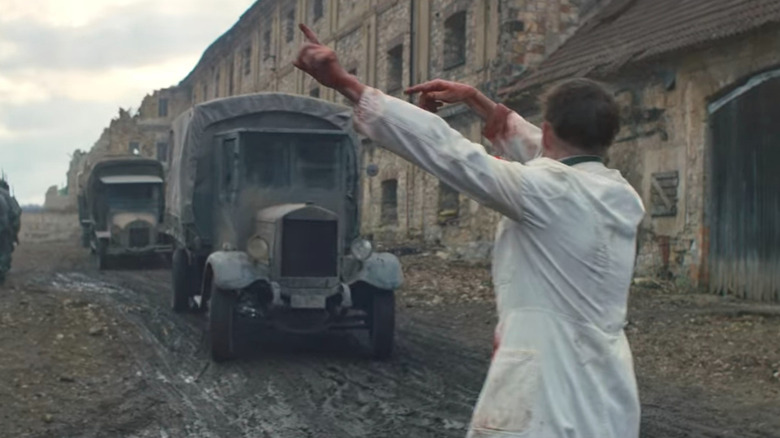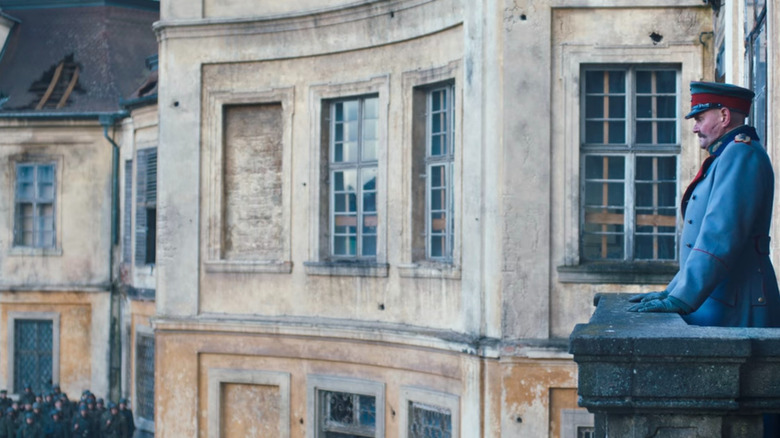The 7 Best And 7 Worst Things About Netflix's All Quiet On The Western Front
Director and co-writer Edward Berger's new adaptation of Erich Maria Remarque's landmark 1928 anti-war novel "All Quiet on the Western Front" is the second major cinematic adaptation of the work after the 1930 film directed by Lewis Milestone that went on to win both best picture ("outstanding production" at the time) and best director at the Academy Awards. In the nearly 100 years since that film's release, technology and filmmaking have evolved significantly, and the new adaptation reflects that.
The new adaptation doesn't just bring color (literally) to the story, but also hugely expands the battle scenes both quantitatively and qualitatively. Though this has nothing to do with new technology, 2022's "All Quiet on the Western Front" also introduces not one, but two new storylines that run parallel to the main storyline drawn from the book.
The main story follows young Paul Baumer (Felix Kammerer) who enlists in the German war effort during World War I with several of his friends. The young men have been inspired to enlist by their teachers who speak of the glory and honor to be found on the battlefield fighting for their country. But when they arrive on the front lines they find nothing but death and destruction. The film then shows moments of their experiences that painfully emphasize the brutality and inhumanity of war.
It's a powerful film, but it's also not without its flaws. Here we'd like to consider what elements work best about this new adaptation — making it a must-watch for fans of the book, the original film, and war films — but also taking a look at what fails and may hold "All Quiet on the Western Front" (2022) back from becoming the same kind of timeless classic as Milestone's adaptation.
Best: The opening(s)
"All Quiet in the Western Front" begins with some credits before showing the audience a beautiful forest at what looks like the dawn. But this beauty is then interrupted by gunfire and images of corpses strewn about the forest floor that are still being struck by ongoing gunfire. The movie then thrusts the viewer into the middle of a chaotic battle wherein we follow a young German soldier until he charges at an enemy combatant, buries a shovel in their shoulder, and the film cuts to the title card.
It's a striking opening that highlights how brutal and matter-of-fact the film will be when it comes to depictions of war violence. What pushes the film's first moments beyond this is that following that jarring sequence, though, is that there is a lengthy wordless montage that shows how the uniforms of dead soldiers on the front are collected, returned to Germany, washed, restitched, and given out once more to new soldiers.
These dual opening sequences show that "All Quiet on the Western Front" isn't only interested in the horror of war from an experiential standpoint, but the conceptual horror of an uncaring war machine that simply swallows a seemingly endless parade of young men.
Worst: The armistice storyline
One of the two new storylines added to this cinematic adaptation of the novel follows real-life diplomat Matthias Erzberger (Daniel Brühl) as he seeks to bring an end to the war by signing an armistice with the Allied Powers represented by the French. The storyline itself is interesting and does some thematic work by calling attention to the major discrepancies between the lives of diplomats and soldiers as well as the abstract ways that diplomats often think about war instead of seriously considering the cost of human life.
The problem with the storyline is that it feels like it's a completely different movie from the main storyline that follows Paul and his comrades on the front. The storylines are, of course, connected as they are both about the war, and the film uses the character of General Friedrichs (Devid Striesow) to tie them together more directly, but the armistice storyline offers the audience a respite from the visceral and horrific experiences of the men on the front, ultimately dulling the impact of the film as a whole.
Best: The production design
The best aspect of the armistice storyline is how it visually highlights the differences between life for Erzberger and the soldiers at the front. Erzberger travels on a luxury train, with fresh fruit, beautiful carpets and curtains, a soft bed, and even slippers. These are likely all period accurate, but the gorgeous detail of the production design really brings these sumptuous amenities to the fore.
Of course, these images wouldn't be so striking if they weren't so harshly contrasted with life on the front where barbed wire and mud are ubiquitous. Production designers Christian M. Goldbeck and Milena Koubová make the front seem endless through the long trenches lined with wet logs and thick clay-like mud. It's a horrible vision, but one that's true to history, making the audience reckon with the conditions soldiers lived in throughout the war.
Even General Friedrichs, who isn't too far from the front, lives a completely different life than the soldiers, he has a roof over his head and well-cooked meals every night. The building where he stays during the film isn't nearly as beautiful or expensive-looking as the train on which Erzberger arrives, but it's still strikingly different from what the soldiers on the ground are living with.
Production design rarely is one of the most outstanding things about a movie, but "All Quiet on the Western Front" uses its various settings to really draw attention to the different lives of those involved with the war.
Worst: General Friedrichs' storyline
Like the added storyline that follows Erzberger, the storyline that follows Friedrichs and his conversations with his apparent right-hand man Major von Brixdorf (Sebastian Hülk) does add something thematically interesting but draws us away from the front and the soldiers there. Friedrichs is a hard man who believes in war and glory and sees the armistice talks as a sign of weakness and cowardice on the part of the government. He does not believe that Germany should surrender and wants to continue fighting until his country and he individually are victorious.
While this viewpoint, from a man who is not at the front, doubles down on the film's thematic interest in the way war is viewed from afar, it also once again draws the film's attention from Paul and the men at the titular front. That this storyline then comes into a devastating collision with Paul's story makes the case for it conceptually, but we'll discuss that more in a moment.
Best: The acting
Felix Kammerer and Albrecht Schuch (who plays Paul's friend and mentor Stanislaus "Kat" Katczinsky) don't have too many scenes between battles on the front, but in the few scenes of stillness they have, the two actors have a significant impact. Kammerer does an incredible job changing Paul's entire way of carrying his body and face from the start of the film where he is a bright-eyed young student excited to go to war for his country to the end where is an almost hollow shell of a man.
And in one of the film's most memorable scenes, when Paul reads the illiterate Kat a letter from his wife, Schuch does some of the best silent-face acting we've seen in a long time. As he listens to Paul read we see him go through nearly every emotion from joy and hope to grief and despair.
While "All Quiet on the Western Front" can't be said to be a character-focused movie, Kammerer and Schuch make sure to make the most of their time on screen and offer us the best look they can into the minds and hearts of these men.
Worst: Not enough time with soldiers
The greatest downfall of this adaptation that holds it back from the highs reached by the first cinematic adaptation is that it doesn't spend enough time with Paul and his fellow soldiers. The book is written entirely in the first person allowing the reader to spend the entirety of the story with Paul and the men around him. While the 1930 film doesn't include an ever-present voiceover from Paul, the story is still entirely focused on him, drawing the reader into his life and his world.
This new movie's added plotlines about Erzberger and Friedrichs may add something conceptually, but they take time away from the soldiers, who should be the only focus of any adaptations of the book. But it's not only these added storylines that draw time and attention away from the inner lives of the men on the front, it's the fact that the time we do spend with them is overwhelmingly spent in battle. These battle scenes certainly spotlight the horror of war, but they don't serve to paint a picture of the inner lives of the soldiers and to draw us into their emotional worlds.
Best: The cinematography
The opening shot of "All Quiet on the Western Front" is a gorgeous view of a forest in what looks like the early morning, with light just beginning to appear and cover the trees. It's a beautiful image that contrasts with the horror of the violence that follows. And that contrast between beauty and horror continues throughout the entirety of the film, sometimes within the same image, and it's all possible because of the simply stunning cinematography courtesy of director of photography James Friend.
Friend makes images of the trenches and no man's land uncomfortably beautiful by lighting them with bright yellow, orange, and red flares that cast their light across the space as they fall. Even scenes of battle are alluring in their high contrast and deep color. It's quite the feat that the movie manages to create such aesthetically pleasing images of a horrific event without ever downplaying the horror of the war that it brings to the screen.
Worst: The runtime
It makes perfect sense that a movie with three different plotlines and numerous lengthy battle scenes has a significant runtime. But the almost two-and-a-half-hour runtime of "All Quiet on the Western Front" begins to feel laborious at some point. It's not that any part of the film is boring in itself, but that the frequent jumps from one story to the other make it more difficult to get caught up in the momentum of any one story or even the characters in any single plot line.
"All Quiet on the Western Front" is a movie that is simply too full of ideas. All of those ideas are interesting, but the movie simply cannot engage all of them and maintain its narrative momentum. So it opts to cram in all its ideas and forfeit any sense of moving along, leading to a movie that feels like it refuses to end. However, that might also be one of the ideas that the movie seeks to convey: that the war simply would not end. Still, just because something works on an intellectual level doesn't mean it works for the movie.
Best: The battle scenes
The major improvement of this adaptation of the novel over the 1930 adaptation is the way that it brings the audience into the battles that the soldiers experience. From the start, the film forces the audience to be in the same physical space as the soldiers, going so far as to follow characters into battle from the safety of the trenches.
These sequences are breathtaking not because they are beautiful but because they are so incredibly tense. We can feel that at any moment any soldier may die, from a bullet, a bayonet wound, a landmine, or even something as comparatively unthreatening as barbed wire. The chaotic camera work and the overbearing sound design serve to make these scenes feel overwhelming and inescapable.
But it's not just the broad strokes of craft that make these scenes so effective. It's the use of specific new (at the time) and devastating weapons like flamethrowers and tanks. The scene that shows flamethrowers being unleashed upon Paul and his comrades emphasizes the impossibility of defending against these weapons as we see Paul left with no other option but to run away even while a friend of his is burned alive. The later sequence in which tanks are used shows the tanks making their assault on the German trenches, not only as defensive vehicles protecting the enemy combatants inside but as massive weapons themselves that are used to roll over and through trenches, crushing men underneath their treads. These scenes are horrifying and make for one of the best elements of the movie.
Worst: The time jump
The great power of the novel and the original 1930 adaptation of it comes from spending time with the young soldiers who are convinced to enlist by their teachers and come to quickly realize, through increasingly brutal experiences, that war is not glorious but, in fact, miserable. It's a key of these narratives that we spend time with these young men as more and more misery and brutality are laid out in front of them and their ideals are snuffed out in the name of the real cruelty of war.
But this new version of the movie jumps ahead 18 months after Paul and his fellow students experience their first battle. It sort of makes the case that the first battle is the only moment of horror the young men need to learn that war is terrible, but it seems at odds with what the novel is fundamentally about. That time jump also doesn't really serve the story of the soldiers, it's only there so that the armistice storyline can begin. It's a strange and awkward choice that highlights this film's interest in the conceptual over the personal.
Best: The themes
"All Quiet on the Western Front" succeeds in bringing the broad anti-war message of the book to the screen as well as some of the more specific themes of loss of innocence and the psychological toll of war on survivors. And while the new storylines about the armistice and General Friedrichs take away from time spent with the soldiers, these stories do add some more thought-provoking ideas to the film through their contrasts with life at the front.
The film's opening also highlights the wholly impersonal and machine-like way that war demands young life, as we see the process of uniforms being recycled from corpses and given to new recruits, presumably only to be recycled once more when those new recruits die in battle. The film's ending, which we'll touch on more in a moment, also speaks to the ultimate meaninglessness of all the death and destruction that attended the First World War in particular.
This adaptation is more interested in the conceptual horrors of war than emotions, and while that is a problem for the story, the movie does manage to offer several thought-provoking and abstractly horrifying moments.
Worst: Lack of emotion
Berger's focus on themes and delivering visceral battle scenes means that we don't get to spend as much time with the soldiers as we've already noted above, and that becomes a problem because it doesn't offer us the time to become fully invested in these characters. The novel and the 1930 adaptation are character driven and focused on the inner lives of the men who live through the war.
Through the time we spend with the men who live and die on the front we develop emotional connections with them and are emotionally impacted when they fall in battle just as their comrades are. But "All Quiet on the Western Front" draws too much time away from the soldiers to focus on characters and stories higher up in the political and military hierarchy leading to a movie that doesn't allow us to become emotionally invested in any of the characters.
This adaptation of the novel is far from a failure, but it doesn't have the same lasting emotional impact that the novel and original adaptation do, and that's disappointing.
Best: The score
It's somewhat surprising the first time we hear an electronic score in "All Quiet on the Western Front." It's a period piece and a war film, both of which usually stick to more orchestral scores, but it also makes a sort of sense that this movie about the inhumanity of war and the way that it simply continues to demand more and more death would be scored with ominous electronic sounds. That electronic theme plays repeatedly throughout the movie and is striking and impactful every time, but it's not alone.
The score, by Academy Award-nominated composer Volker Bertelmann, includes quiet moments as well. Some are created by synths, while others are brought to life by strings and piano. And those orchestral instruments are also used in more energetic and overwhelming ways as well, particularly the strings and percussion sections that Bertelmann uses to claustrophobic effect during some of the film's more intense moments.
It's a score that initially calls attention to itself before becoming part of the world of the movie, which is what all the best scores do. It lifts up the film that it's a part of but doesn't go wholly unnoticed as a piece of great music itself.
Worst: The ending
This new adaptation's ending differs significantly from the ending of the book. There, Paul dies a month before the armistice is signed, as Remarque wrote, "on a day that was so quiet and still on the whole front, that the army report confined itself to the single sentence: All quiet on the Western front." This emphasizes that Paul's death is insignificant to the larger war, a young man who we have come to care for has lost his life, but it makes no difference to the uncaring war.
By contrast, in the 2022 movie, the armistice is signed and announcements are made of the ceasefire taking place at 11 a.m. on the 11th of November before the final battle scene. That battle takes place because General Friedrichs is dissatisfied with what he perceives as weakness on the part of the ruling government and decides that before the official ceasefire, while he is still legally permitted to engage in aggression, he will force the men under his command to make a final attack.
It's a devastating irony that drives home the utter meaninglessness of the massive loss of life in the war, especially in the final moments when peace has already been announced. But it overplays the responsibility of one man in a story that is meant to be about the ways that the war machine destroys individual lives. This change doesn't just change the novel's final message, but is also at odds with the way the rest of the movie portrays war, as something beyond any individual person's control.
